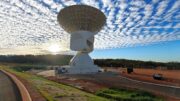The launch campaign of the next satellite to join the Copernicus Sentinel-1 mission is progressing on schedule for launch on Tuesday, 4 November, on board an Ariane 6 rocket.
The Sentinel-1 mission delivers radar images of Earth’s surface, performing in all weathers, day-and-night. This service is vital for disaster response teams, environmental agencies, maritime authorities, climate scientists – and other users who depend on frequent updates of critical data.

Sentinel-1D is the mission’s next satellite and is set to join its sibling, Sentinel-1C. When fully commissioned, it will substitute Sentinel-1A, which has been in orbit for 11 years, well beyond its planned lifetime.
Sentinel-1D and -1C will generate data and imaging using a C-band synthetic aperture radar (SAR) instrument, which captures high-resolution imagery of Earth’s surface. They are also equipped with an Automatic Identification System (AIS) instrument to improve detection and tracking of ships. When both are operational, more frequent AIS observations will be possible.
The spacecraft Flight Readiness Review took place last week, paving the way for fuelling of Sentinel-1D.
The mission’s Project Manager, Thibaut Decoopman, explained that the team is now finalising the satellite configuration for launch, prior to preparing the spacecraft for encapsulation. He said, “Since it arrived in French Guyana, Sentinel-1D has successfully completed the last integration steps and undergone the functional tests. The satellite is now fuelled and in good health, perfectly on-time for mating onto the launcher, thanks to the continuous dedication of our industry colleagues and ESA team members.”
The satellite will be encapsulated on Friday, 24 October.

Source: ESA










Be the first to comment on "Sentinel-1D fuelled and ready for encapsulation"